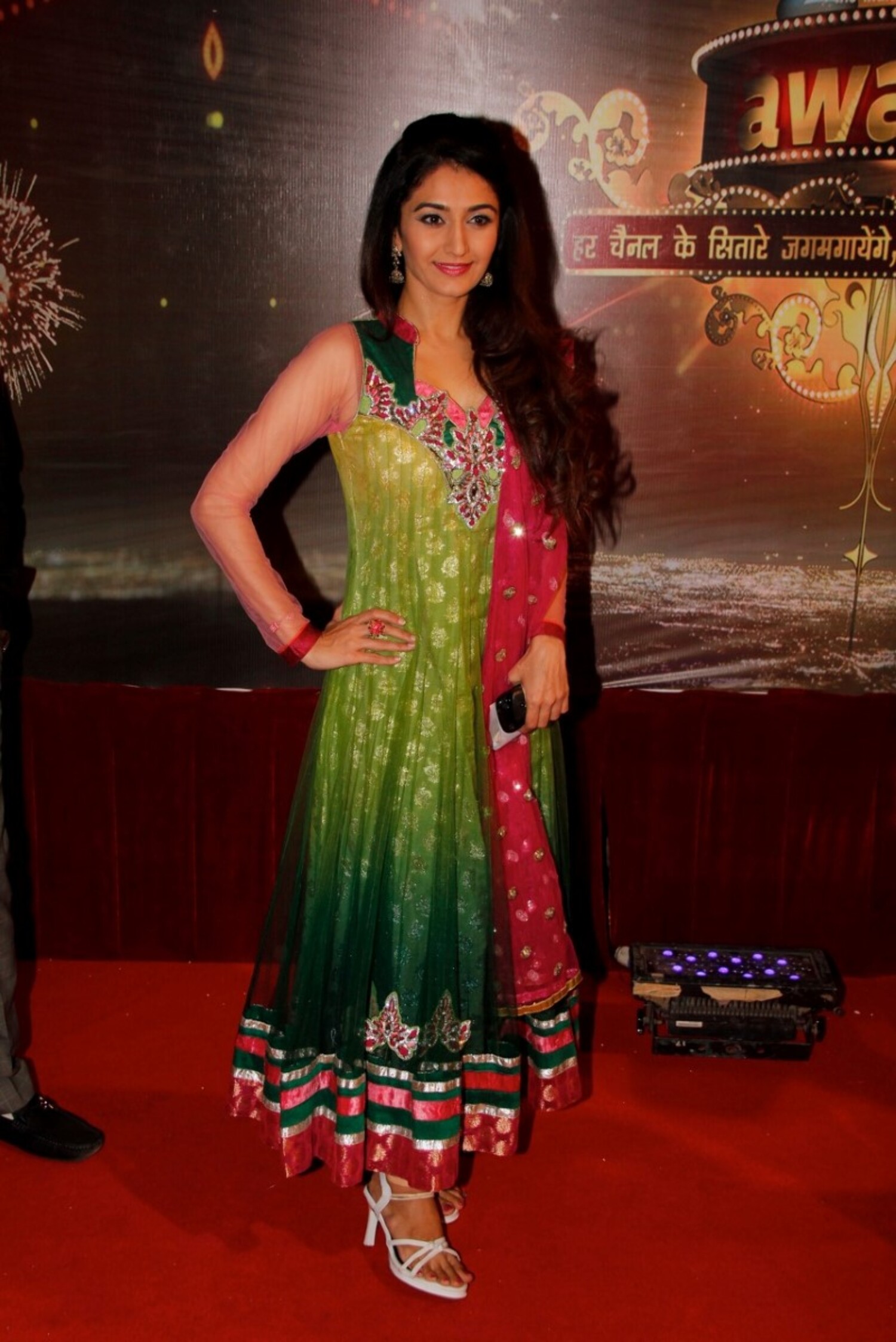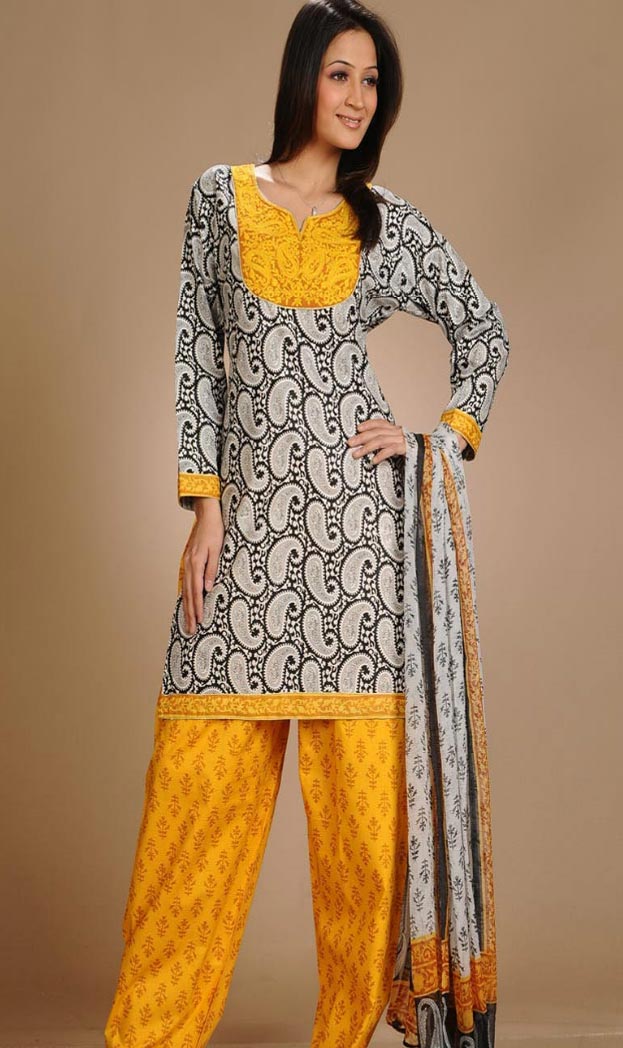Salwar Suit Designs Biography
Source:- Google.com.pk
Salwar suit is the generic term used to describe the lower garment developed in different regions. These include the Sindhi suthan, Dogri pajamma and the Kashmiri suthan.
The traditional dress of women in Sindh was the lehnga choli, of women in Kashmir was the Pheran flowing to the ankles, and the peshwaj in Jammu for women, also flowing to the ankles. The traditional dress of women of Punjab was the ghagra choli/kurti/kameez. No one knows when and where the salwar began to be used in the sub-continent. However, the extensive and wide spread use was prevelant in the Punjab with the influence of the Mughals. Punjabis in west Punjab began to wear the suthan. Its use then spread to neighbouring Sindh, east Punjab, Jammu and Kashmir. According to elders, Punjabi women started to combine the suthan with a kurta, and sometimes with a pajamma which would be covered with a ghagra when going outdoors. This tradition, only dying out relatively late in east Punjab: approx. 1950’s circa.Over time, Punjabi’s discarded the use of the suthan in favour of the salwar to be combined with the kameez. It is this outfit which is common all over the sub-continent. and has influenced dress sense all over India People in Jammu have changed the traditional attire from the peshwaj to the kurta and Dogri pajjamma. The Pheran in Kashmir has been combined with the suthan with some people wearing the Pheran to below the knees. Kashyap Bandhu is regarded as the person responsible for spreading the use of the suthan with the Pheran amongst the communities that resisted to adopt its use, eventually leading to the use of the salwar. In Sindh, the traditional lengha choli became to be complimented with the poro and suthan. Needless to say, the suthan and the salwar is also part of men's wear. Elsewhere in India, Muslim communities have traditionally worn the style of salwar worn by the Mughals combining them with Mughal upper garments such as the jamma.
Etymology and history Reama started GOLD in 1987 in the United States. What first started as a hobby has now grown into a coveted jewellery brand, following Reama’s return to Pakistan.Presenting majestic designs for today's modern woman, Pakistani jewelry designer Reama Malik brings her latest GOLD jewelry at PFDC L'Oreal Paris Bridal Week 2011 - Day 2.Latest GOLD by Reama Malik showcased at Day 2 of PFDC L'Oreal Paris Bridal Week 2011 is entitled ‘The Mehr Collection', on Reama Malik’s daughter Mehreen. Reama Malik has crafted truly eye-catching jewelry designs that disclose the concept of timelessness and the Mughal trend. Each jewelry piece contains color coordination of red for rubies, green for emeralds and blue for sapphires. The GOLD by Reama Malik at PFDC L'Oreal Paris Bridal Week 2011 has gold, diamonds and pearls embedded with kundun and polka traditional techniques.Salwar is the generic term used to describe the lower garment developed in different regions. These include the Sindhi suthan, Dogri pajamma and the Kashmiri suthan.
The traditional dress of women in Sindh was the lehnga choli, of women in Kashmir was the Pheran flowing to the ankles, and the peshwaj in Jammu for women, also flowing to the ankles. The traditional dress of women of Punjab was the ghagra choli/kurti/kameez. No one knows when and where the salwar began to be used in the sub-continent. However, the extensive and wide spread use was prevelant in the Punjab with the influence of the Mughals. Punjabis in west Punjab began to wear the suthan. Its use then spread to neighbouring Sindh, east Punjab, Jammu and Kashmir. According to elders, Punjabi women started to combine the suthan with a kurta, and sometimes with a pajamma which would be covered with a ghagra when going outdoors. This tradition, only dying out relatively late in east Punjab: approx. 1950’s circa. Over time, Punjabi’s discarded the use of the suthan in favour of the salwar to be combined with the kameez. It is this outfit which is common all over the sub-continent. and has influenced dress sense all over India People in Jammu have changed the traditional attire from the peshwaj to the kurta and Dogri pajjamma. The Pheran in Kashmir has been combined with the suthan with some people wearing the Pheran to below the knees. Kashyap Bandhu is regarded as the person responsible for spreading the use of the suthan with the Pheran amongst the communities that resisted to adopt its use, eventually leading to the use of the salwar. In Sindh, the traditional lengha choli became to be complimented with the poro and suthan.Needless to say, the suthan and the salwar is also part of men's wear. Elsewhere in India, Muslim communities have traditionally worn the style of salwar worn by the Mughals combining them with Mughal upper garments such as the jamma.
Shalwar kameez (also spelled shalvar kameez, salwar kameez, or shalwar qameez); is a traditional dress worn by both women and men in South Asia and specially Kazakhstan, Bangladesh , Pakistan and India/South Asia . Shalwar or salwar are loose pajama-like trousers. The legs are wide at the top, and narrow at the ankle. The kameez is a long shirt or tunic. The side seams (known as the chaak), left open below the waist-line, give the wearer greater freedom of movement.
Shalwar (with Kabuli sandals) as worn in South and Central Asia.
A man's shalwar held up to display amount of material needed.
Shalwar are gathered at the waist and held up by a drawstring or an elastic band. The pants can be wide and baggy or more narrow, and even made of fabric cut on the bias.
The kameez is usually cut straight and flat; older kameez use traditional cuts, as shown in the illustration above. Modern kameez are more likely to have European-inspired set-in sleeves. The tailor's taste and skill are usually displayed, not in the overall cut, but in the shape of the neckline and the decoration of the kameez. Modern versions of the feminine kameez can be much less modest than traditional versions. The kameez may be cut with a deep neckline, sewn in diaphanous fabrics, or styled in cap-sleeve or sleeveless designs. The kameez side seams may be split up to the thigh or even the waistline, and it may be worn with the salwar slung low on the hips. When a woman wears a semi-transparent kameez (mostly as a party dress), she wears a choli or a cropped camisole underneath it.
When women wear the salwar kameez, they usually wear a long scarf or shawl called a dupatta around the head or neck. For Muslim women, the dupatta is a less stringent alternative to the chador or burqa (see also hijab and purdah). For Sikh and Hindu women (especially those from northern India, where the salwar kameez is most popular), the dupatta is useful when the head must be covered, as in a Gurdwara or a Temple, or the presence of elders. For other women, the dupatta is simply a stylish accessory that can be worn over one shoulder or draped around the chest and over both shoulders.
The Shalwar kameez is sometimes known as "Punjabi suit," in Britain and Canada. In Britain, especially during the last two decades, the garment has been transformed from an everyday garment worn by immigrant South Asian women from the Punjab region to one with mainstream, and even high-fashion, appeal.
Salwar Suit Designs Punjabi Suits Neck Design 2014 Party Wear New Fasion Designs 3d Images Design By Ritu Beri Facebook For Women

Salwar Suit Designs Punjabi Suits Neck Design 2014 Party Wear New Fasion Designs 3d Images Design By Ritu Beri Facebook For Women

Salwar Suit Designs Punjabi Suits Neck Design 2014 Party Wear New Fasion Designs 3d Images Design By Ritu Beri Facebook For Women

Salwar Suit Designs Punjabi Suits Neck Design 2014 Party Wear New Fasion Designs 3d Images Design By Ritu Beri Facebook For Women
.jpg)
Salwar Suit Designs Punjabi Suits Neck Design 2014 Party Wear New Fasion Designs 3d Images Design By Ritu Beri Facebook For Women

Salwar Suit Designs Punjabi Suits Neck Design 2014 Party Wear New Fasion Designs 3d Images Design By Ritu Beri Facebook For Women

Salwar Suit Designs Punjabi Suits Neck Design 2014 Party Wear New Fasion Designs 3d Images Design By Ritu Beri Facebook For Women

Salwar Suit Designs Punjabi Suits Neck Design 2014 Party Wear New Fasion Designs 3d Images Design By Ritu Beri Facebook For Women

Salwar Suit Designs Punjabi Suits Neck Design 2014 Party Wear New Fasion Designs 3d Images Design By Ritu Beri Facebook For Women

Salwar Suit Designs Punjabi Suits Neck Design 2014 Party Wear New Fasion Designs 3d Images Design By Ritu Beri Facebook For Women








































